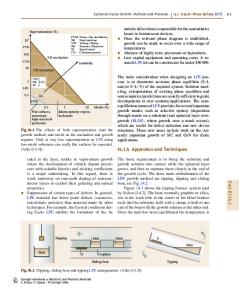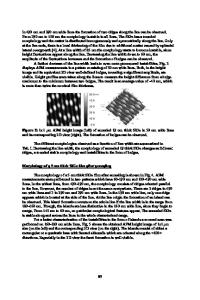Surfactant-Mediated Si/Ge Epitaxial Crystal Growth
- PDF / 268,807 Bytes
- 6 Pages / 414.72 x 648 pts Page_size
- 35 Downloads / 363 Views
1
ABSTRACT
We investigate the kinetic role of a surfactant in the epitaxial Si/Ge crystal growth using ab initio molecular dynamics approach. We examine the previously suggested dimer-exchange mechanisms and find that kinetics plays a crucial role in determining the exchange process. We further find that the diffusion of adatoms on an island in the presence of a surfactant is quite different from the dimer-exchange process on a flat surface.
2
INTRODUCTION
Despite the fact that the current sophisticated growth techniques provide various novel systems of quantum structures, there exists an intrinsic problem in an heterostructure formation that A material can grow easily on B material whereas the opposite is always difficult to achieve due to the surface free energy difference between two materials. For instance, the Ge on a Si layer can grow layer-by-layer at least a few monolayers whereas the followed Si deposition on the Ge overlayered structure does not always leave an abrupt interface due to the Ge segregation to the front growing surface, which is induced by the surface free energy difference. One way to overcome this difficulty is to introduce a surfactant prior to the Ge deposition. This lowers the surface free energy drastically and therefore the Ge segregation is suppressed by surfactants being at the front growing surface and thus the interface becomes abrupt. Several experiments have been done to investigate the role of surfactants [1-4]. Since Tromp and Reuter suggested a needlelike dimer-exchange process based on low energy electron microscope measurement that the As dimer grows along the direction of the dimer row [3], several calculations based on the energetics have been performed to explain surfactant-mediated growth [5,6]. Eaglesham et al. have reported that the post annealing of Ge islands on the Si(001) surface in the presence of Sb surfactants reduces the islands drastically [4]. These observations suggest that the role of surfactants on islands and on a flat surface are quite different and furthermore under135 Mat. Res. Soc. Symp. Proc. Vol. 448 01997 Materials Research Society
standing these phenomena requires the evaluattion of the activation energies to assure the related atomic motion. In this report we emphasize that it is not the energetics but the kinetics that governs the dimer-exchange process and the annealing of islands. Introducing ab initio molecular dynamics (MD) method, we evaluate the previously suggested dimer-exchange mechanisms by constructing appropriate pathways and examine the validity of these models. We also evaluate kinetics on islands in the presence of surfactants and prove that the islands are annealed out by enhancing the diffusion of adatoms on the island in the presence of Sb at the edge of islands.
3
THEORETICAL APPROACHES
For the dimer-exchange process on a flat surface, we construct a periodic supercell which contains four layers of Si (4x2), one monolayer of Ge, and the surfactant (Sb) along the Si(001) direction. The dangling bonds of the bottom Si
Data Loading...










